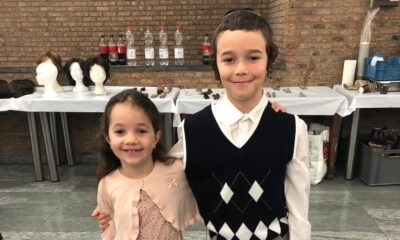
Lifestyle

The stories behind ‘The Beauty Queen of Jerusalem’
Sarit Yishai-Levi is giving fresh insight into the fascinating history of Sephardi Jews in Jerusalem during Ottoman and British rule.
Yishai-Levi is the author of the best-selling novel on which the hit Netflix series The Beauty Queen of Jerusalem is based. This multi-generational family saga – now in its second season on Netflix – is set pre-1948 and highlights both the history of Israel and Sephardic-Ashkenazi relations.
An eighth-generation Israeli, Yishai-Levi delved into her family’s Sephardic roots in writing her first novel, published in 2015. “My ancestors were Ladino speaking,” she says, referring to the Judeo-Spanish language spoken by Sephardic Jews. “They were what we call here in Israel Samech-Tet, Hebrew for Sephardim Tehorim (pure Sephardim). It’s a unique community that’s not very well known in Israel.” While Jews who originate from the Iberian Peninsula, North Africa, and the Middle East call themselves Sephardic, the Sephardim Tehorim traced their lineage directly back to Spain.
While her family gave insights into the book’s historical backdrop, Yishai-Levi stresses that it’s a work of fiction. “It’s based on memories, stories, legends, and characters that I heard about in my family, but it’s definitely not autobiographical,” she says.
Yet she spent hours listening to her father’s first-hand accounts of what life was like in Jerusalem under British rule. “My father lived in Jerusalem, and I live in Tel Aviv, and I used to travel once a week to Jerusalem, where we’d sit in a café and he’d walk down memory lane.
“All that I’ve written about the lives of young people in Jerusalem during the British Mandate is from what my father told me. Which cafés they went to, where they danced, where they flirted, where they made love, and where they’d travel for picnics. It was like I received a present. I was very privileged to sit with my father for extended periods and let him be young again. He even chose the name of the family in my book.”
Her father’s experiences as a fighter in World War II in the Jewish Brigade in Italy served as inspiration for the character of David, who follows a similar path in the book.
Sadly, her father passed away shortly before The Beauty Queen of Jerusalem was published.
Yishai-Levi was a renowned journalist in Israel before she wrote the novel at the age of 65. She was the first woman and Israeli to interview former Palestinian Liberation Organization leader Yasser Arafat. Her journalistic background led her to Tel Aviv’s Beit Ariela Shaar Zion Library. “I’d sit in the press section, because I’m a journalist and I knew that I’d find everything I needed in the newspapers.”
Scanning old clippings, she found material for everything from furniture the Ermoza family had, to the fashion, theatre shows, music and popular cars of the time, and details on the political environment. It was also there that the seeds for the major conflict in her book were sown. “While I was looking at old newspapers, I found a very interesting article in HaZvi, one of the first Hebrew newspapers published in Israel,” Yishai-Levi explains. “There I saw an article condemning the heads of the Sephardic community because they wouldn’t let their daughters and sons marry Ashkenazim,” she continues. “I was amazed, I didn’t know that.”
Yishai-Levi was so intrigued that she decided that her main character, the Sephardi Gabriel Ermoza, would fall in love with an Ashkenazi girl, and not only Ashkenazi, but also very religious. “It’s a very dramatic point in the book.”
While the explanations she found for the rift differed, the prevailing thought seemed to be that many Sephardim at that time in Jerusalem were well educated and considered themselves to be the elite. Conversely, the Ashkenazim who initially came to Israel under the rule of the Ottoman Empire came from small towns in Eastern Europe, were generally less educated and relatively poor. Yet there is no academic text that clearly proves this historical distinction.
When Yishai-Levi’s first novel became a bestseller, television production houses came knocking. While the resulting series is not 100% true to the book, with the second series in fact completely different, she says that the production was rooted in a genuine love of the story.
“It’s a great compliment when your first book becomes a TV series, it’s a great compliment when Netflix spreads it all over the world,” she says. “It might not be nice to say, but my bank manager is also very happy about it, so I’m happy.”
Now, The Beauty Queen of Jerusalem is set to become a stage production at Beit Lessin in Tel Aviv.
Reflecting on what she wants people to gain from the story, she says the answer is different for non-Jewish and Jewish communities. “When my book was published in Italy, I was interviewed by a well-known journalist in the country. When she said, ‘I didn’t know there were Jews in Jerusalem before the Six-Day War’, I was shocked. So, from my book, I want everyone to learn that there are many generations of Jewish people in the land of Israel and in Jerusalem.”
Her message to the Jewish community is one she says is particularly relevant considering the political turbulence in Israel. “I can’t believe I’m saying it in these times, but maybe it’s the right time to say it. We are here in Israel; our roots are here. And we’re never going to leave it. We’ll keep on fighting for Israel, for our values, our beliefs, and our democracy. I hope we’ll win eventually and keep our beautiful country and home democratic and peaceful.”










